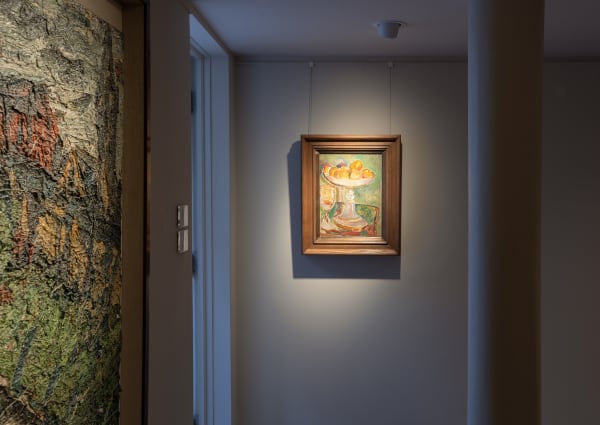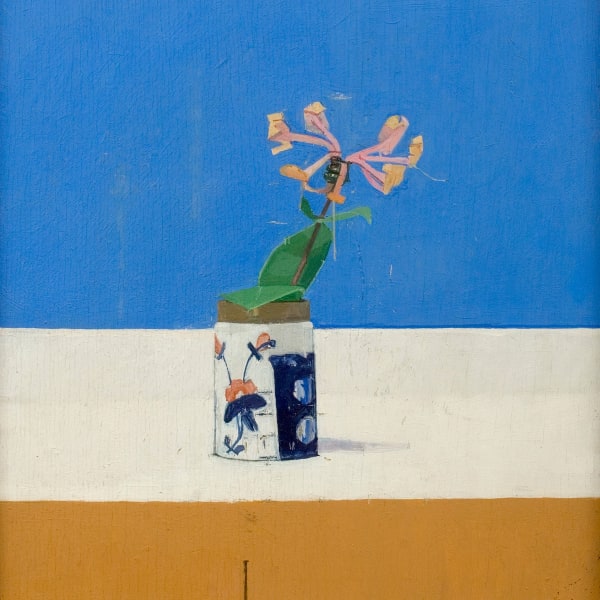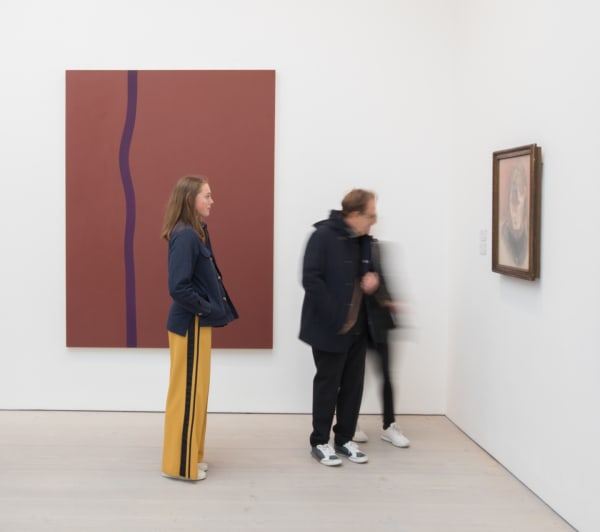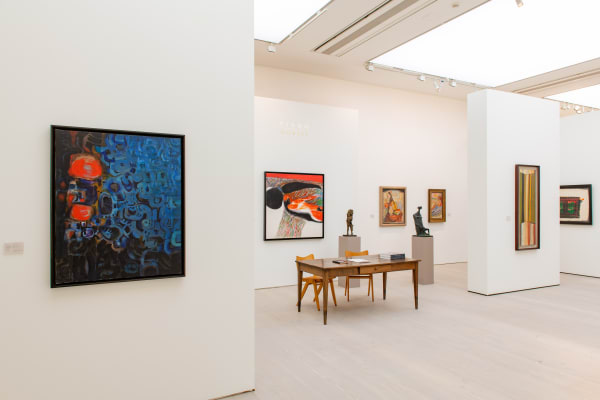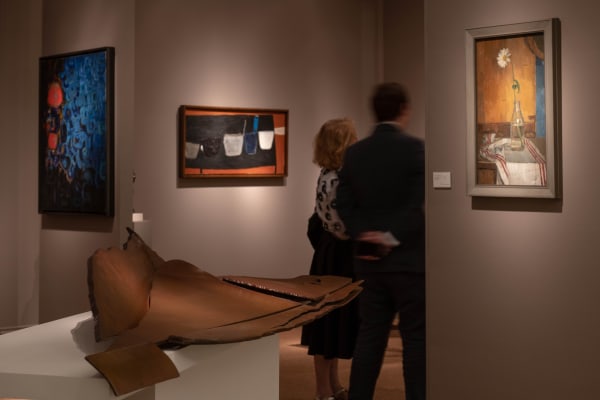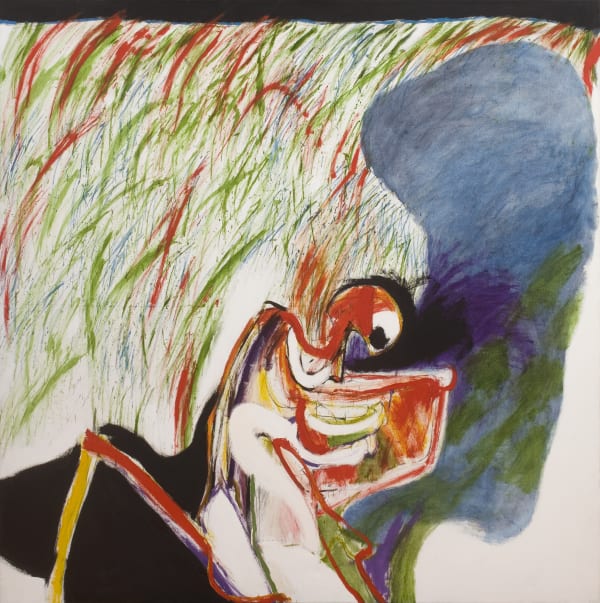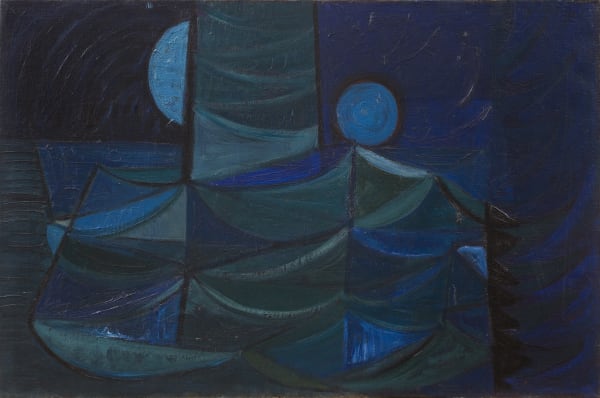William Crozier
The gallery regularly handles, acquires and advises on works by William Crozier. For further information or the availability of works, please contact the gallery.
William Crozier (1930–1911)
Crozier was born in Glasgow to Irish parents and educated at the Glasgow School of Art between 1949 and 1953. On graduating he spent time in Paris and Dublin before settling in London, where he quickly gained a reputation as the 1950s equivalent of a Young British Artist through the early success and notoriety of his exhibitions of assemblages and paintings at the ICA, Drian and the Arthur Tooth galleries, with whom he had a long association.
Profoundly affected by post-war existential philosophy, Crozier allied himself and his work consciously with contemporary European art throughout the 1950s and 1960s, rather than with the New York abstractionists, who were more fashionable in the UK at the time. He was also part of the artistic and literary world of 1950s Soho, a close associate of 'the Roberts', Colquhoun and Macbryde, John Minton and William Scott, and part of the expatriate middle-European and Irish intellectual circles in London of the time. By 1961 Crozier was widely seen as one of the most exciting artists in London. He had his first one-man exhibition that year at Arthur Tooth and Sons which toured to the Kunstverein in Hannover the following year.
His intellectual and painterly concerns were closely aligned to the adventurous group of abstract artists which included his close friends Roger Hilton and Terry Frost. Crozier spent 1963 in southern Spain with the Irish poet Anthony Cronin; this proved pivotal to Crozier's development as an artist. On his return to the UK, he began a series of skeletal paintings which anticipated the 'New Expressionist' German painters of the 1980s, and which were influenced by Crozier's visits to Auschwitz and Belsen. A visit to Bergen-Belsen in the 60’s left an indelible mark, and as Philip Vann has commented; for Crozier, ‘The skeleton is still very much a sentient human being: vulnerable, dignified, alone and abandoned in a landscape of astonishing beauty.' In 1964 the Arts Council included his paintings in the exhibition Six Young Painters with David Hockney, Peter Blake, Allen Jones, Bridget Riley and Euan Uglow. In 1975 Crozier was grouped alongside Francis Bacon in the important exhibition Body and Soul at the Walker Art Gallery, Liverpool.
Based in London throughout the 1960s and 1970s, Crozier exhibited his works in London, Glasgow, Dublin and all over Europe. As many artists of the 1960s did, Crozier combined painting with teaching, first at Bath Academy of Art, (with Howard Hodgkin, Gillian Ayres and Terry Frost), then at the Central School of Art and Design (with William Turnbull and Cecil Collins), at the Studio School in New York and finally at Winchester School of Art where he led a strong centre for painting based on the European tradition. When he ceased teaching in the 1980s, Crozier's painting blossomed with a new freedom and confidence. His abstract landscapes and still life painting used sumptuous colour to convey an emotional intensity and he was endlessly concerned with the challenge of creating a new language in figurative painting.
Crozier's paintings are now in demand at exhibition and at auction. He represented the UK and Ireland overseas, and has been awarded the Premio Lissone in Milan and the Oireachtas Gold medal for Painting in Dublin in 1994. In 1991 the Crawford Art Gallery Cork and the Royal Hibernian Academy curated a retrospective of his work. He was elected to Aosdana in 1992 and was an honorary member of the Royal Hibernian Academy. In 2005 Crozier celebrated his 75th birthday with a major exhibition in Cork to celebrate the European Capital of Culture. Here Crozier exhibited a selection of his drawing work, providing the first opportunity to see that the master of colour was also an inventive artist in black and white.
Crozier's work has recently been purchased by the National Gallery of Ireland and the Scottish National Gallery. Commenting to the Keeper of the Scottish National Gallery, in relation to the museum’s acquisition of Burning Field Essex, Crozier explained: ‘It is the custom in Essex for farmers to burn the stubble in the fields after harvest. . . making them black and dark against the skyline. It was reminiscent of those magnificent photographs of the battlefields in France and Flanders during the First World War. I have always found a fascination in this kind of desolate and ravaged landscape.’
-
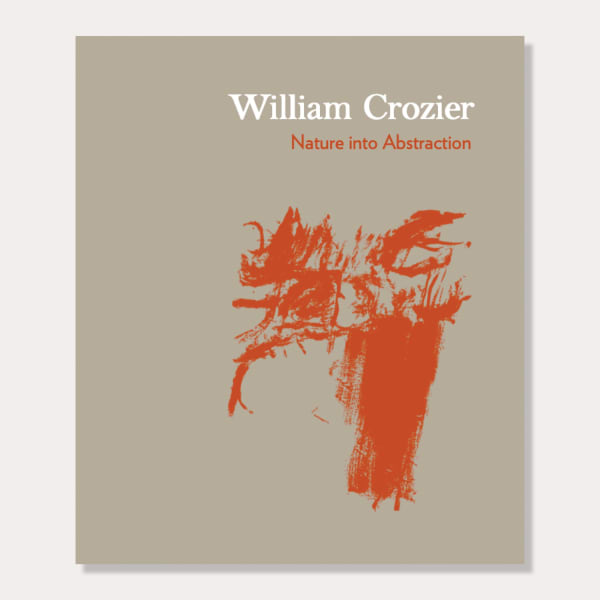
William Crozier
Nature into Abstraction 2022SoftbackRead more
Publisher: Piano Nobile
ISBN: 978-1-901192-61-2
Dimensions: 28 x 24cm -

William Crozier
Seize the Flow'r 2022Softback, 55 pagesRead more
Publisher: Piano Nobile
ISBN: 978-1-901192-60-5
Dimensions: 28 x 24cm -

William Crozier
The Edge of the Landscape Coulter, Riann; Crouan, Katharine; Glennie, Sarah; Hudson, Mark; Juncosa, Enrique; Kissane, Sean; Turner, Sarah, 2017Softback, 144 pagesRead more
Publisher: Irish Museum of Modern Art (IMMA), Dublin
ISBN: 978-1-901192-48-3
Dimensions: 32 x 28 cm -

Aspects of Abstraction 1952-2007
Margaret Garlake, 2016Hardback, 80 pagesRead more
Publisher: Piano Nobile Publications
ISBN: 9781901192438
Dimensions: 28.8 x 24.6 x 1.3 cm -

William Crozier
Works 1958-1964 2013Booklet, 8 pagesRead more
Publisher: Piano Nobile Publications
Dimensions: 15 x 20 cm -

20th Century Modern British Art
Developments in Modern British Art 2013Booklet, 8 pagesRead more
Publisher: Piano Nobile Publications
Dimensions: 15 x 20 cm
-

Abstract Painting in Britain
1960–65 19 Sep - 6 Dec 2024 Piano NobileA parallel presentation to Ben Nicholson: Defining Works 1929-1954, the exhibition featured abstract paintings made in Britain between 1960 and 1965. Whereas Nicholson’s work was often infused with constructivist precision...Read more -

William Crozier
Nature into Abstraction 14 Feb - 22 Mar 2024 Piano NobileBetween 1958 and 1961, William Crozier (1930—2011) was making paintings inspired by his encounters with landscape. The results were not ‘landscapes’, ‘cityscapes’ or even ‘pictures’ but freeform expressions of his...Read more -

Treasure House Fair
Royal Hospital Chelsea 22 - 26 Jun 2023 Art FairThe Treasure House Fair is a celebration of outstanding and rare art and antiques. Held at The Royal Hospital Chelsea the fair continues the tradition of its predecessors, Masterpiece and...Read more -

William Crozier
Seize the Flow'r 11 Mar - 31 May 2022 Piano NobileReturning from a visit to New York in 1979, William Crozier had a rush of creative energy. Newly confident in his European identity and inspired by art of the past,...Read more -

Defining British Art
1910 - 2000 17 May - 23 Jul 2021 Piano NobileThis exhibition reviewed the major creative outbursts in twentieth-century Britain, with paintings, sculptures, ceramics and textiles made by four generations of pioneering artists – from Sickert at the fin de...Read more -

Masterpiece
Online Viewing Room 22 - 28 Jun 2020Highlights from our online display included work by Ben and Winifred Nicholson, William Turnbull, Leon Kossoff, Frank Auerbach, William Crozier, David Bomberg, Lucian Freud and Barbara Hepworth . Also on...Read more -

British Art Fair
Saatchi Gallery 3 - 6 Oct 2019 Art FairPiano Nobile exhibited at the British Art Fair in 2019. Following the fair's great success in 2018, it was held at the Saatchi Gallery for a second year running. The...Read more -

William Crozier
Early Works 27 Sep - 30 Oct 2019 Piano NobileWilliam Crozier | Early Works presented an exclusive selection of Crozier's oils and works on paper from the 1950s-70s. The show offered visceral and ravaged Essex Landscapes alongside existential Skeletal...Read more -

British Art Fair
Saatchi Gallery 20 - 23 Sep 2018 Art FairPiano Nobile presented a selection of Post-War and Modern British art, including works by Craigie Aitchison, Kenneth Armitage, David Bomberg, Peter Coker, William Crozier, Leslie Marr, Leon Kossoff, Paul Nash,...Read more -

Masterpiece
Royal Hospital Chelsea 28 Jun - 4 Jul 2018 Art FairPiano Nobile presented a selection of Modern and Contemporary British and International artists including works by Anthony Caro, Leon Kossoff, Euan Uglow, Paul Nash, Mark Gertler, William Crozier, Craigie Aitchison...Read more -

Modern British Masters (III)
Selected Highlights 29 May - 20 Jun 2018 Piano NobileContinuing a series of exhibitions on the theme, Piano Nobile presented a display of Modern British Masters. Stretching from the birth of modern art at the beginning of the twentieth...Read more -

William Crozier
Savagery Beneath the Surface 3 Oct - 15 Dec 2017William Crozier: Savagery Beneath the Surface was an exhibition showcasing the paintings of William Crozier, staged in collaboration with a major retrospective of Crozier’s entire career held at the Irish...Read more -

Masterpiece
Royal Hospital Chelsea 27 Jun - 5 Jul 2017 Art FairThe gallery presented a selection of Modern and Contemporary British and International artists including works by William Scott, Tracey Emin, Lucian Freud, Augustus John, Duncan Grant and Vanessa Bell, Eduardo...Read more -

Aspects of Abstraction
1952-2007 17 May - 23 Jun 2016 Piano NobilePiano Nobile presents a selection of Post-War abstract art for sale, Modern British art for sale, in Aspects of Post-War Abstraction exhibition.Read more -

British Self-Portraits: Highlights from the Ruth Borchard Collection
Pallant House Gallery, Chichester 18 Oct 2014 - 31 May 2015Pallant House Gallery, Chichester, in conjunction with Piano Nobile, presented an exhibition of highlights from the Ruth Borchard Collection of self-portraits by British artists brought together by Ruth Borchard throughout...Read more -

ART14
Olympia Grand 28 Feb - 2 Mar 2014 Art FairPIANO NOBILE exhibited at Art14, the second edition of London's global art fair. With galleries from Lagos to Berlin, and from Beijing to Dubai, Art14 London built on the success...Read more -

William Crozier
Works 1958 - 1964 16 Oct - 7 Dec 2013 Piano NobileOne man show of the work of William Crozier, focusing on the years 1958 1964 at Piano Nobile GalleryRead more -

20th Century British Art
Developments in Modern British Art 20 Jun - 20 Jul 2013 Piano Nobile20th Century: Modern British Art - Developments in Modern British ArtRead more
Piano Nobile Gallery
Summer show with selected works following the developments in 20th Century British Art
-

William Crozier Gallery Talk with Thomas Marks & Katharine Crouan
March 13, 2024The talk considers Crozier's paintings from 1958-62, which are the focus of the current exhibition at the gallery, open until 22 March 2024. The discussion also looks at how these paintings relate to his later works and the wider art historical context of post-war British art. Thomas Marks is a leading writer and art critic. He was editor of Apollo from 2013-21 and has contributed to numerous publications, among them Prospect, Literary Review and the Times Literary Supplement. Marks has written and lectured widely on historical and contemporary art, and...Read more -
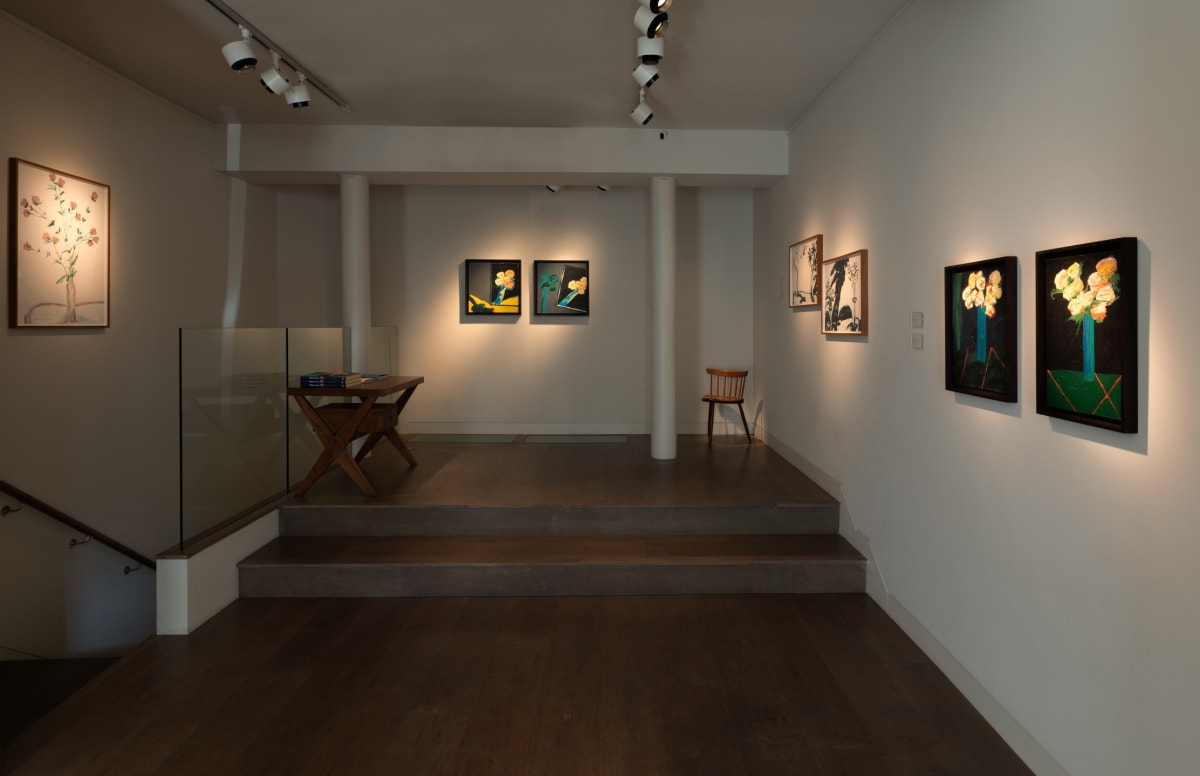
William Crozier Seize the Flow'r
Exhibition March 11, 2022Read more
-

William Crozier | Nature into Abstraction
artdaily.com February 1, 2024Artdaily.com features Piano Nobile's William Crozier | Nature into Abstraction exhibition.Read more -

Top 5 Theatre Show & Art Exhibition Picks
Culture Calling February 1, 2024Culture Calling highlights Piano Nobile's William Crozier | Nature into Abstraction exhibition as one of their Top 5 Art & Theatre Exhibitions to visit.Read more -

InSight No. 122
William Crozier | Figure in Landscape, circa 1972 April 5, 2023To mark the twenty-fifth anniversary of the Good Friday Agreement, InSight considers the Irish artist William Crozier’s Figure in Landscape – a profound painting touching...Read more -

William Crozier at The Lightbox Woking
Nature into Abstraction April 2, 2022Between 1958 and 1961, William Crozier produced a series of daring and original landscape paintings. He lived in north Essex at the time and found...Read more -

InSight No. 99
William Crozier | Still Life March 16, 2022To coincide with Piano Nobile’s new exhibition William Crozier: Seize the Flow’r, InSight considers a significant group of still life paintings made by Crozier upon...Read more -

InSight No. 28
William Crozier | Black Lake July 21, 2020In 1964, William Crozier appeared in a remarkable Arts Council exhibition of ‘Six Young Painters’. Amidst work by Peter Blake, David Hockney and Bridget Riley,...Read more -

William Crozier: The Edge of Landscape is reviewed in Studio International
March 1, 2018William Crozier: The Edge of Landscape , a major retrospective of the artists work at the Irish Museum of Modern Art, Dublin, has been reviewed...Read more -

The Sunday Times reviews William Crozier exhibition
Cristin Leach August 6, 2017William Crozier exhibition, review, The Sunday Times art review, Irish Times art review, Irish artist exhibitionRead more -

William Crozier: The Edge of the Landscape
West Cork and Dublin May 23, 2017The Irish Museum of Modern Art (IMMA), Dublin, together with the West Cork Arts Centre, Skibbereen, and Piano Nobile, Kings Place are to present a...Read more -

Imperial War Museum acquires major William Crozier painting
London October 25, 2015London's Imperial War Museum acquires a painting by William Crozier.Read more -

National Gallery of Ireland acquire Crozier from Piano Nobile
William Crozier October 18, 2012William Crozier's Flanders Fields (1962) - one of the most recent acquisitions at National Gallery of Ireland from Piano Nobile, London - goes on view...Read more












